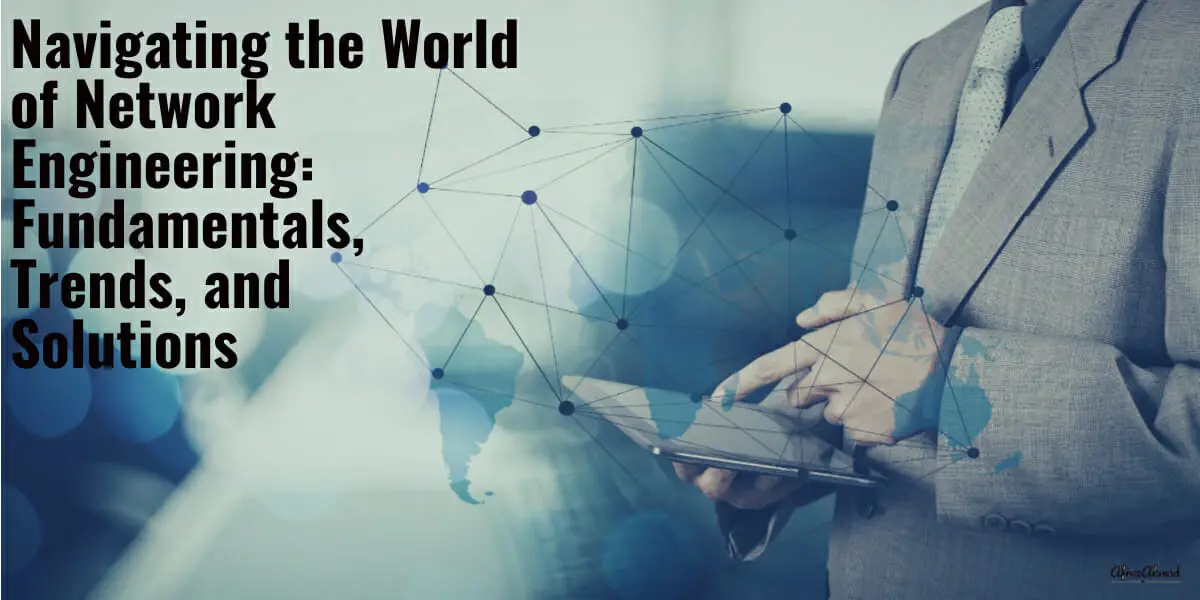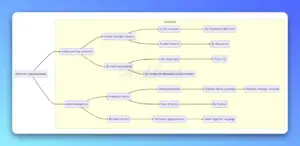Welcome to the world of network engineering, where cables are the cobblestone streets, and servers are the skyscrapers. It’s a world where the only thing that’s constant is change and where the only way to navigate is by understanding the fundamentals and keeping up with the latest trends.
As a seasoned network engineer, I’ve had the opportunity to work on some pretty cool projects over the years, and I’m excited to share my insights with you, from the importance of fundamentals such as OSI layer and networking protocols to the changing trends in the field such as automation, cloud computing, and 5G. We’ll also explore the reliability and diversity of a career in network engineering and the importance of skills such as Linux, Docker, and Kubernetes.
Think of this article as a map and compass for your journey in network engineering. It will guide you through the maze of cables, servers, and trends and help you understand the why, what, and how of network engineering. So buckle up and get ready for a journey that’s both exciting and challenging, like climbing Mount Everest but with less altitude sickness.
Key Takeaways – Summary
- 🌐 Network engineering is a dynamic and rewarding field, requiring knowledge of fundamentals and staying abreast of new technologies.
- 🚦 A career in network engineering is reliable, offering diverse opportunities across various industries and necessitating a blend of technical and soft skills.
- ⚙️ Mastering core networking concepts like TCP/IP, OSI model, and routing protocols is essential, akin to learning an alphabet before reading.
- 🤖 Automation and machine learning are revolutionizing network operations, reducing errors and increasing efficiency.
- 🌍 Edge computing and IoT are shaping the future of network engineering, necessitating low-latency, high-bandwidth networks.
- 🖥️ Network virtualization, including SDN and NFV, is transforming network design and management, offering flexibility and scalability.
- ☁️ Cloud networking requires understanding multi-cloud environments, security, and different service models (IaaS, PaaS, SaaS).
- 🐳 Proficiency in Linux, Docker, and Kubernetes is crucial for modern network engineering, reflecting the trend towards containerization.
- 🚀 Future trends include network slicing, network as a service (NaaS), 5G, intent-based networking, and AI/ML integration.
- 📚 Continuous learning and skill development are imperative in network engineering to keep pace with evolving technologies.
- 💬 Balancing technical expertise with soft skills like communication and problem-solving is key to a successful network engineering career.
A Reliable Career: Network Engineering
When it comes to choosing a career, reliability is key. And that’s exactly what network engineering is: a reliable career. It’s like having a steady job as a lighthouse keeper; the ships will always need to be guided to shore. Network engineers are in high demand across various industries, such as healthcare, finance, manufacturing, and retail. It’s like being a jack of all trades, and you can work in any industry that relies on a network.
But the role of network engineers isn’t just about keeping the ships sailing; it’s also about ensuring business continuity and disaster recovery. It’s like being a lifeguard; you’re there to keep the network safe and make sure it’s up and running in case of an emergency. Network engineers are responsible for designing and implementing network solutions that ensure the availability and accessibility of mission-critical applications and data.
Cloud computing has also had a significant impact on network engineering. It’s like having a bigger lighthouse; it provides more visibility and reaches. Network engineers need to understand multi-cloud and hybrid-cloud environments to be able to design, deploy and manage network solutions that are scalable, secure, and compliant.
Finally, soft skills such as communication and problem-solving are essential for a network engineering career. It’s like being a good leader; you need to be able to communicate effectively with your team and understand the business objectives to be able to provide the best solution. Network engineers need to be able to explain complex technical concepts to non-technical stakeholders and work with cross-functional teams to design and implement network solutions that meet business needs.
In short, network engineering is a reliable career that offers a diverse range of opportunities across various industries. It’s a career that requires a combination of technical and soft skills, and it’s a career that will always be in demand. So, if you’re looking for a career that’s like a steady job as a lighthouse keeper, network engineering is the way to go.
Fundamentals and Trends in Network Engineering: Navigating the Sea of Change
When it comes to network engineering, understanding the fundamentals is like having a compass on a ship; it helps you navigate the sea of change. One of the most important fundamentals in network engineering is understanding networking core concepts such as TCP/IP, OSI model, and routing protocols. It’s like learning the alphabet before you can read a book; without it, you’ll be lost in translation.
Another important trend in network engineering is automation and machine learning. It’s like having a GPS on your ship; it helps you navigate more efficiently and effectively. Automation and machine learning are impacting network operations and management by reducing human error, increasing efficiency, and providing better visibility into network performance. It’s like having a captain who never gets tired or makes mistakes; it’s a game-changer.
Edge computing and IoT are also shaping the future of network engineering. It’s like having a radar on your ship; it helps you navigate in real-time and anticipate potential obstacles. The need for low-latency, high-bandwidth networks is increasing with the growing number of IoT devices and the need for real-time data processing. It’s like having a faster ship; it helps you reach your destination faster and more efficiently.
Finally, network virtualization is changing the way networks are designed, deployed, and managed. It’s like building a ship in a virtual world before it’s built in the real world; it’s more efficient and cost-effective. Network virtualization technologies like SDN and NFV are allowing network engineers to create virtual networks on top of physical networks, providing more flexibility and scalability. It’s like having a ship that can transform into a submarine; it’s versatile and adaptable to different environments.
In short, understanding the fundamentals and keeping up with the latest trends in network engineering is like having a compass, GPS, radar, and a transformable ship; it helps you navigate the sea of change more efficiently and effectively.
Cloud Networking: Navigating the Skies of Change
When it comes to networking, the shift toward the cloud is like flying a plane instead of sailing a ship. It’s faster, more efficient, and provides more reach. VPS and Cloud servers are becoming the norm and are replacing traditional data centers. It’s like having a bigger airport; it provides more destinations and more flexibility. This shift has implications for both data centers and network infrastructure; it’s like having a bigger airplane but needing new routes and new navigation systems.
But just like flying a plane, security is a major concern in cloud networking. It’s like having a security check before boarding a plane; it ensures that only authorized personnel have access to sensitive information. Security protocols such as SSL/TLS, VPN, and firewalls are essential for protecting data and ensuring compliance in cloud environments. It’s like having a security system on the plane; it ensures that the plane and the passengers are safe.
Public cloud networking also has different models, such as IaaS, PaaS, and SaaS. It’s like having different types of airplanes; each one has its own strengths and weaknesses. IaaS provides infrastructure, PaaS provides a platform, and SaaS provides software. Understanding these differences is essential for designing and implementing cloud networking solutions that meet business needs.
Another important aspect of cloud networking is network automation and orchestration. It’s like having a pilot who can fly the plane and navigate it at the same time. Network automation and orchestration help to reduce human error, increase efficiency, and provide better visibility into network performance. It’s like having a smart pilot; it ensures that the plane is always on the right course. Skills in DevOps and infrastructure as code are essential for network automation and orchestration.
In short, cloud networking is like flying a plane instead of sailing a ship; it’s faster, more efficient, and provides more reach. But just like flying a plane, security and compliance are major concerns. Understanding the different models of public cloud networking and the importance of network automation and orchestration are essential for designing and implementing cloud networking solutions that meet business needs.
Data Center Networking: The Future is Software-Defined
When it comes to data center networking, the future is all about software-defined networking (SDN) and network function virtualization (NFV). It’s like having a computer fly the plane instead of a human; it’s more efficient and provides more flexibility. SDN and NFV allow for the separation of the control and data planes, making it easier to design, deploy, and manage networks. It’s like having a virtual co-pilot; it ensures that the plane is always on the right course.
But just like flying a plane, the future of data center networking is also about speed and bandwidth. It’s like having a faster plane; it provides more destinations and more flexibility. 5G and edge computing are driving the need for low-latency, high-bandwidth networks. It’s like having a supersonic plane; it ensures that the passengers have a smooth and fast ride.
But flying a plane also requires monitoring and analytics. It’s like having a traffic controller; it ensures that the plane is on the right course and that there are no collisions. Network monitoring and analytics tools are essential for understanding network visibility and troubleshooting in data center networks. It’s like having radar, and it ensures that the pilot can see the other planes and can avoid collisions.
In short, data center networking is about software-defined networking and network function virtualization. It’s about speed, bandwidth, network monitoring, and analytics. The future of data center networking is all about software-defined, with 5G and edge computing driving the need for low-latency, high-bandwidth networks.
Gaining Expertise in Linux, Docker, and Kubernetes: Containerize Your Networking Skills
When it comes to network engineering, Linux is the backbone of many network systems. It’s like having a sturdy foundation, and it ensures that the building is stable. Understanding Linux is essential for network engineers; it’s like having a key to the building, which ensures that you can access all the rooms.
But just like a building, network systems are also becoming more modular and efficient. It’s like having smaller rooms; it ensures that the building is more flexible. This is where containers come in; they allow for the isolation of applications and services. It’s like having smaller rooms; it ensures that the building is more flexible. Docker and Kubernetes are popular tools for container management, and they ensure that the containers are deployed and scaled efficiently. It’s like having a janitor; it ensures that the rooms are clean and organized.
But containers also have an impact on network engineering. It’s like having smaller rooms; it ensures that the building is more flexible. Understanding container networking and service meshes are essential for network engineers. It’s like having a map of the building; it ensures that you can navigate the rooms efficiently.
In short, Linux, Docker, and Kubernetes are like having a sturdy foundation, smaller rooms, and a map of the building. Understanding Linux is essential, learning Docker and Kubernetes is beneficial, and understanding container networking and service meshes is important for network engineers. So, containerize your networking skills and navigate the world of network engineering with ease.
Future of Network Engineering: The Sky’s the Limit
When it comes to the future of network engineering, the possibilities are endless. New technologies and trends are shaping the field like never before, and it’s important for network engineers to stay up to date on these developments in order to stay relevant in their careers.
One of the major trends in the future of network engineering is the concept of network slicing. This technology allows for the creation of multiple virtual networks within a single physical network, each with its own specific characteristics and requirements. This allows for more efficient use of network resources and can be especially useful in industries such as manufacturing and transportation, where different types of data traffic may need to be separated and managed independently.
Another trend in the future of network engineering is the concept of the network as a service (NaaS). This technology allows for the outsourcing of network management and maintenance to third-party providers, allowing organizations to focus on their core competencies and outsource non-core functions. This can be especially useful for small and medium-sized businesses that may not have the resources or expertise to manage their own networks.
5G technology is another trend that will shape the future of network engineering. 5G networks will offer faster speeds, lower latency, and increased capacity. This will have a significant impact on industries such as healthcare, finance, and retail, as it will enable new technologies such as IoT, Augmented Reality, and autonomous vehicles.
Intent-based networking is another trend that will shape the future of network engineering. This technology uses machine learning algorithms to automatically configure and manage network devices based on predefined business objectives. This can significantly reduce the need for manual intervention and improve network performance.
The future of network engineering also includes the use of Artificial Intelligence (AI) and Machine learning (ML) to automate network operations and management, improve network security and optimize network performance. Network engineers will need to have a good understanding of these technologies to stay competitive in their field.
In short, the future of network engineering is all about new technologies and trends such as network slicing, network as a service, 5G, intent-based networking, and AI/ML. Network engineers need to stay up to date on these developments to stay relevant in their careers.
Conclusion: The Network Never Stops
We’ve covered a lot in this article, from the importance of fundamentals in network engineering to the latest trends and technologies shaping the field. But one thing is clear, in the world of network engineering, the network never stops. It’s constantly evolving and changing, and as a network engineer, it’s important to stay on top of these changes.
One of the key takeaways from this article is the importance of understanding the fundamentals of network engineering. No matter how advanced technology becomes, the basic principles of networking will always apply. It’s like building a house, and you need a strong foundation to build upon.
Another important point is the need for continuous learning and development in network engineering. The field is constantly changing and evolving, and as a network engineer, it’s important to stay up to date on the latest technologies and trends. Whether it’s studying for certifications or attending industry conferences, there are always opportunities to expand your knowledge and skills.
Finally, we can’t forget the importance of both technical and soft skills in network engineering. The role of a network engineer is not just about configuring routers and switches; it’s also about being able to communicate effectively with stakeholders, troubleshoot problems, and think critically. A combination of both technical and soft skills is essential for success in the field of network engineering.
In conclusion, network engineering is a challenging and rewarding field that’s constantly evolving. By understanding the fundamentals, staying up to date on new technologies and trends, and developing a combination of technical and soft skills, network engineers can stay ahead of the game and navigate the ever-changing landscape of networking.
- NETGEAR Nighthawk (RAX54S) WiFi 6 Router Review - August 24, 2024
- TP-Link AX1800 Archer AX21 WiFi 6 Router Review - August 24, 2024
- How to Connect Nanit to Hotel WiFi? - August 12, 2024




